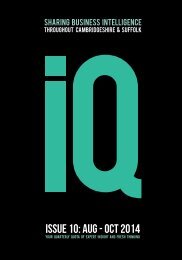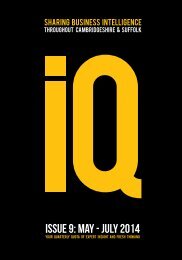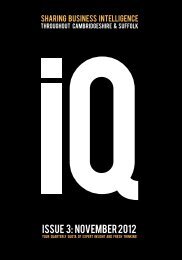IQ-Magazine-Issue-14
Create successful ePaper yourself
Turn your PDF publications into a flip-book with our unique Google optimized e-Paper software.
misses the mark. It is rare that there will be much equity established in a misplaced<br />
identity.<br />
Consistent communication is key<br />
When it comes to actually communicating the brand to both customers and<br />
prospects there is one vital rule - be consistent. Always use a consistent logo, in a<br />
consistent format. Always use colours consistently. For example, if purple is used<br />
to highlight an action that a customer/prospect can take on your website, then<br />
use purple to denote an action in other forms of communication too. Consistency<br />
breeds familiarity – make yourself instantly recognisable via consistent and clear<br />
brand visuals and messaging to avoid confusion. You have seconds to engage<br />
a customer and motivate them to take action; constantly changing the way you<br />
are asking customers and prospects to access information is time consuming and<br />
confusing from their perspective and they may ultimately decide to go elsewhere<br />
because of it.<br />
Knowing when to stop<br />
Another common stumbling block occurs in the creation of multiple, separate<br />
brands and identities for different parts of a proposition – for example for a<br />
specific product or a service in a particular industry sector. This ‘house of brands’<br />
approach is more common within the FMCG sector and is very successfully<br />
delivered by organisations such as Proctor & Gamble, who effectively run each<br />
brand as a separate business, each with its own unique and targeted identity and,<br />
importantly, with the independent budgets to support it.<br />
Adopting this approach as an SME is often extremely challenging, particularly if<br />
the necessary budget to support the building of awareness and consideration for<br />
two or more brands, rather than one, just isn’t available. In this situation a ‘house<br />
of brands’ approach can lead to confusion, which will ultimately result in a dilution<br />
of brand equity in all areas rather than success.<br />
In this scenario it is again better to fix it rather<br />
than allow the problem to perpetuate. A more<br />
successful and manageable strategy here could<br />
be to create strength through a ‘branded<br />
house’ approach – think Virgin. When<br />
deciding to take action though, it is important<br />
to understand the equity established in each<br />
brand before deciding which one to stick with.<br />
We have experience of situations where the<br />
product brand has become more synonymous<br />
with the business and has a more positive<br />
impact on customers than the overall business<br />
brand. In these cases, careful consideration of which brand to retain is crucial.<br />
Be committed<br />
Whichever route you choose, be it a complete re-brand or the development of an<br />
existing brand, it’s vital to have a robust plan in place for the roll out of that brand.<br />
It is also imperative that you commit to it and above all, are consistent in the way in<br />
which you communicate it. If you don’t believe in it yourself, how can you expect<br />
anyone else to?<br />
<strong>IQ</strong> business planning<br />
MAKE YOURSELF<br />
INSTANTLY<br />
RECOGNISABLE<br />
VIA CONSISTENT<br />
AND CLEAR<br />
BRAND VISUALS<br />
issue <strong>14</strong> | page 37


















